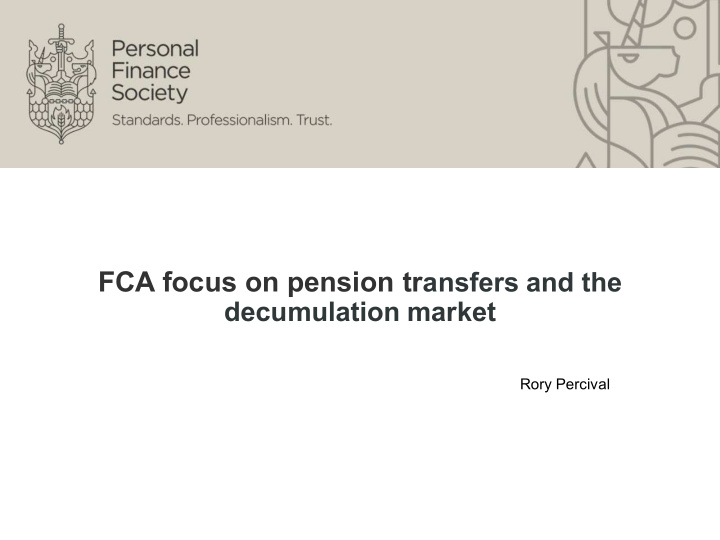



FCA focus on pension tr ansfers and the decumulation market Rory Percival
Introduction by Mark MacLean FPFS Essex Region Chair
DB Transfers and Retirement Income Advice
Agenda • Regulatory context • DB transfer suitability • What can we learn from DB transfers? • Behavioural biases • Centralised retirement propositions • Summary Actions
Learning objectives By the end of this session you should … • Understand the FCA’s view on suitability of DB transfers • Understand the likely FCA concerns about the retirement income market • Understand the problems that exist in many firms currently • Consider changes, developments and good practice
Regulatory context • Senior Managers and Certification Regimes (SM&CR) • PROD • Assessing Suitability Review 2 (ASR2)
https://www.fca.org.uk/publication/guidance-consultation/gc20-01.pdf
DB transfer suitability • Ill health - yes • Younger clients – no, unless ill • Schemes in trouble – ‘overplayed’ • High transfer values – ‘sceptical’ • Death benefits - maybe • You can’t have your cake and eat it (unless you are ‘lucky’ and die young) • Other alternatives (life cover?) • Prioritise income need • Flexibility - maybe • Really? What for and when? • Prioritise income need • Workplace pensions
It’s not the client’s choice …
What can we learn from DB transfers?
Record-keeping: Personal information
Record-keeping: financial assets
Record-keeping: objectives
Record-keeping: expenditure
Taxonomy of income
Suitability reports
Suitability reports: poor practice
Attitude to transfer risk (COBS 19.1.6(4)(b) G)
Annuities: • Provide secure, level or increasing pension for life • Uses the pension fund to buy (ie no fund left) • Can opt to include spouse’s pension on death (amount optional) • Tax-free lump sum (up to 25%) available if you want • Doesn’t require managing or reviewing • Generally, benefits and taxation position less likely to change • Higher income available if in poor health or have certain lifestyle (eg smoker) Flexible personal arrangement • No security of income; income depends on investment returns and charges • Tax-free lump sum (up to 25%) can be taken without having to take income • Flexibility to take further (taxed) lump sums • Flexibility to increase, decrease, stop and start income • Hence, need to review and manage income, lump sum and investment return levels to ensure income is sustainable throughout life • Unused fund passed to beneficiaries on death (usually tax-free if taken as a fund)
What is your view now? What do you think your view will be in your later years, say 80s and 90s? What is your view on the risks and benefits of having an annuity? What is your view on the risks and benefits of having a flexible personal arrangement? What is your view on the certainty of income in retirement? You have outlined what additional amounts you will need in the future, over and above your regular income. Do you think there is the possibility that you will need to access further funds from a flexible personal arrangement? If so, please provide details What is your experience of, and attitude towards, paying for advice on investments so long as the funds last? What is your view on the limitations of access from an annuity (ie that you can have a tax-free lump sum and secure income but no further access or flexibility) Would you like to leave assets to your children? If so, how much? Does this include the value of your pension scheme? How important is this given that this will reduce the level of benefit you can have in retirement?
Behavioural biases Annuities • Criticised as poor value – what does this mean? • Investment v insurance • What value security? • Diversification
Retirement income strategies • Annuity/safety first • Sustainable withdrawal rate (SWR) • Buckets • Natural income • Security and flexibility • Or mix
Centralised retirement proposition (CRP) • Firm-level framework • Segmentation • Sub-segmentation (security v flexibility) • Formality
Actions … 1 • Read GC 20/1 (advisers: chapters 3 – 6) • Benchmark against good and poor practice • Agree/record views on suitability • Training • Set up a project to create or review your approach to retirement income advice – your CRP • Report to Board with initial plans and subsequent recommendations, for sign off
Actions … 2 • Review fact-find: • Questions about security v flexibility • Detail about income needs – essential, lifestyle, discretionary • How income needs will vary • Format of questions on objectives • Sub-segment retirement income clients • Build framework for what type of retirement income solution meets the different sub-segments (recognise outliers) • Research and due diligence on solution products and providers • Training • Documentation – new or refresh • Manage adviser biases • Manage client biases • Implementation
Learning objectives By the end of this session you should … • Understand the FCA’s view on suitability of DB transfers • Understand the likely FCA concerns about the retirement income market • Understand the problems that exist in many firms currently • Consider changes, developments and good practice
Questions …
Next Essex Event Tuesday 20 October 8am New Professionals ‘Breakfast’ Meeting with Adam Owen Booking soon at www.cii.co.uk/chelmsford
Thank you for attending
Recommend
More recommend